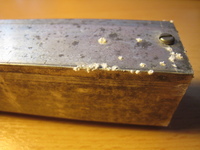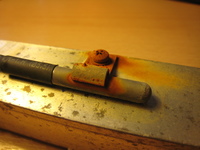In the previous article regarding the capacitive water level sensor, I've presented two different electrode designs:
- A coaxial electrode made from a rectangular aluminium tube an a single isolated wire as "central conductor"
- A simple twin-wire electrode made from simple speaker-wire
Here my findings regarding each electrode.
Twin-wire electrode
The twin-wire electrode has in my opinion one major drawback - the electrode is symetrical but the sensor circuit is earth referenced. This leads to a very high sensitivity against noise. Another drawback is, that the fluid is not between the two conductors, as the room between the two wires is filled with plastic isolation material.
Positive is, that the construction costs are really low and the material selection is fairly simple.
Coaxial electrode
The coaxial electrode gives a far more stable sensor reading, as the complete wiring from the wire inside the tube up to the NE555 is completely shielded.
But as can be seen in these pictures, the selection of the right material is far more critical:
These pictures are from a simple aluminium tube after 5 days in pure rain water.

My next action will be a visit at the local plumber to get a stainless-steel tube - then I will re-run these tests ...

